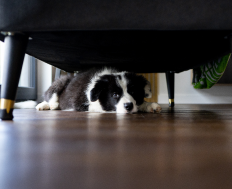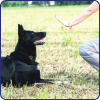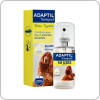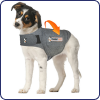
What Emotions Do Dogs Feel? A Happy Dog Expert Explains!
All mammals – including humans and non-humans – feel a broad range of emotions, some of which are a lot more complex than others. But what about our four-legged friends? Do dogs feel emotions too?
Of course, the answer is yes! And what’s more, being able to recognise what emotions our dogs are feeling will help us better understand their behaviour.
By Veterinary Behaviourist Angela Gonzalez
What Emotions Do Dogs Feel?
The most basic emotions in dogs and other mammals are known as primary emotions, or emotional systems, and follow quite primitive brain circuits. These circuits filter out external stimuli to create an internal representation of any circumstance and then trigger a resulting behavioural response.
This means that different emotions can all be represented by certain behaviours. Or in other words, just because a dog behaves a certain way, this does not mean they are always feeling the same emotions. But if different emotional states all produce a similar outward behaviour, how do we understand what emotions our dogs are feeling?
One of the first questions to consider is “how can we talk about the emotions of dogs if they are not able to express them verbally?”. Interestingly, part of the answer to this question lies in the fact that emotions are not the same as "emotional feelings" as we understand them in human terms.
So, when we talk about dogs and their emotions, we are instead going to talk about emotional-motivational systems; that is, about very instinctive neural circuits.

Primary Emotions in Dogs
From the neuro-scientific point of view, emotional-motivational systems, or primary emotions, can be classified into (table:1):
-
Desire-seeking system
-
Frustration system
-
Fear-anxiety system
-
Pain system
-
Panic-grief system
-
Care system
-
Lust system
-
Social play system

Desire-Seeking System
The activation of the desire-seeking system makes dogs intensely motivated to explore the environment around them. This canine emotion allows them to anticipate and find the resources they need to survive: water, food, warmth, cold, and companionship.
The desire-seeking system is not really a "reward" or "pleasure" system. In reality, it appears to be a more general neural system that causes dogs and other animals to move to places where they can find and consume the resources they need to survive.
Normal behaviours related to this system are hunting behaviour, individual play, seeking social interaction and exploration of the environment. Behavioural problems related to hunting, exaggerated attention seeking from caregivers, or destruction due to play are mediated by the activation of the desire-seeking system.

Frustration System
The Frustration System is activated when an attempt is made to restrict an animal's freedom to do what they would like, or when there is a failure to meet expectations, obtain resources, or retain control. Frustration is related to aggressive behaviours when a dog has no control over a situation, is irritated, or feels restricted. This emotion in dogs also helps them defend themselves by provoking fear in their opponents.
Examples of this system are the aggressive reactions in cases where a dog tries to bite another dog but ends up biting the caregiver who holds them by the collar. Or similarly, the aggressiveness that a dog can show when another enters their territory.
Fear-Anxiety System
The fear-anxiety system relates to the management of threats to personal safety or resources. This helps animals avoid dangers as they are more adapted to feel anticipatory fear (anxiety) than to be attacked and harmed.
When the emotional system is intensely stimulated, it causes a dog to flee or avoid the stimulus. When the stimulation is weaker, a dog may stay still, "freeze", and inhibit their behaviours. When the animal cannot use these avoidance or flight strategies, they can react aggressively.
An example of behavioural problems related to fear-anxiety are phobias. However, these canine emotions are not mutually exclusive, so it is common for a dog to feel both fear/anxiety and frustration at the same time.
Pain System
The pain system is related to maintaining the integrity and functioning of the body. The activation of this system is a response to environmental stimuli that are related to actual or potential damage to the body.
Panic-Grief System
The motivational-emotional systems discussed above are related to how animals protect themselves and their resources individually. However, this system relates more to the protection of the species than the individual, to the protection of the survival of the offspring, and thus to the protection of the genetic survival of the species.
Before they are able to protect themselves, puppies begin to exhibit powerful emotional arousals that indicate desperate needs for care. This emotion in dogs is most clearly reflected in the whining of puppies that are lost or when they are left alone in unfamiliar places.
The main function of these separation vocalisations is to alert mothers to seek them out, retrieve them, and attend to the needs of their young, reflecting a need for social contact. It can also be activated in adult dogs when they are separated from their attachment figure, an example being home alone.
Care System
For mothers to be motivated to invest enormous amounts of time and energy in their offspring, there needs to be a strong bond between them. The care system is dedicated to maintaining the bond with the offspring through parental care.
This canine emotional system is triggered shortly before the offspring are born, through well-described hormonal changes. The behavioural effects of this system are that the mother cares for her young after birth and for a long period of time, until they are able to care for themselves.
Normal behaviours mediated by this system are the care of the young, but also behaviours that serve to deepen the bonds between adults such as resting together or grooming each other. Some behavioural problems related to the care system could be pseudo-pregnancy (phantom pregnancy), maternal aggression, or rejection of the litter by the mother.

Lust System
The lust system organises reproductive needs ranging from attraction or selection of a mate through courtship, to any potential bonding, to mating with a sexual partner.
Behavioural problems related to this system are mounting problems, urine marking, escaping to find females in season or excessive vocalisations during fertile periods.
Social Play System
Social mammals need to develop various skills in order to be part of a social group. The social play system is a specific brain circuit that can provide certain information to individuals about their own social capacity and potential in relation to others.
Social play should be discriminated from object play because the brain circuits are different, and the play styles meet different needs. Social play is activated by the social play system, and as discussed above, object play is activated by the desire-seeking system.

So, we can see that there are eight motivational-emotional systems, or primary emotions in dogs, but they are not exclusive. That is, at a given time, several systems can be activated at the same time. For example, when a dog who is tied up in the street is aggressive towards another dog, they may do so because they are afraid of the other dog, making them feel frustration because the leash does not let them escape.
Secondary Emotions in Dogs
Primary emotions are the most basic emotions that can be found in mammals, and it was long believed that these were the only ones that dogs possessed. Today, we have more of an understanding that dogs, like humans, can have more complex emotions than we previously thought. These are generally classified as "secondary emotions".
Secondary emotions in dogs require them to have self-awareness and the ability to interpret social situations. In this sense, several studies have shown that dogs are self-aware, differentiate their own smell from that of other individuals, are aware of their own size, and they are aware that their body may be in the way of picking up an object that is underneath them.
On the other hand, other studies have shown that when a caregiver interacts with other individuals, dogs show behaviours very similar to those shown by jealous young children. In addition, they have been seen to show empathy; dogs show signs of stress when they hear whining sounds from other dogs. It has also been shown that dogs are able to detect inequality, so they react negatively when a person rewards another dog in front of them and they do not receive a reward.
Guilt is an emotion that has been attributed a lot to dogs, however, there is no scientific evidence that they experience it. In fact, what is usually called a "guilty face" is actually an expression of stress that the dog makes when it sees its angry caregiver.
Dogs are sentient animals that experience emotions. Being able to understand and recognise them is a great tool for caregivers, trainers, and veterinarians to preserve the welfare of dogs.
For more fascinating insights into our dogs, their emotions, and how they experience the world around them, why not keep exploring all our Happy Dog Expert articles online? Or to receive the latest news straight into your inbox, sign up for our email newsletter and we’ll keep you updated with everything we’re up to!








































